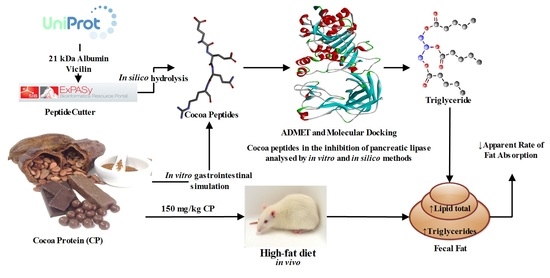Cocoa (Theobroma cacao L.) Seed Proteins’ Anti-Obesity Potential through Lipase Inhibition Using In Silico, In Vitro and In Vivo Models
Abstract
Share and Cite
Coronado-Cáceres, L.J.; Rabadán-Chávez, G.; Mojica, L.; Hernández-Ledesma, B.; Quevedo-Corona, L.; Lugo Cervantes, E. Cocoa (Theobroma cacao L.) Seed Proteins’ Anti-Obesity Potential through Lipase Inhibition Using In Silico, In Vitro and In Vivo Models. Foods 2020, 9, 1359. https://doi.org/10.3390/foods9101359
Coronado-Cáceres LJ, Rabadán-Chávez G, Mojica L, Hernández-Ledesma B, Quevedo-Corona L, Lugo Cervantes E. Cocoa (Theobroma cacao L.) Seed Proteins’ Anti-Obesity Potential through Lipase Inhibition Using In Silico, In Vitro and In Vivo Models. Foods. 2020; 9(10):1359. https://doi.org/10.3390/foods9101359
Chicago/Turabian StyleCoronado-Cáceres, Luis Jorge, Griselda Rabadán-Chávez, Luis Mojica, Blanca Hernández-Ledesma, Lucía Quevedo-Corona, and Eugenia Lugo Cervantes. 2020. "Cocoa (Theobroma cacao L.) Seed Proteins’ Anti-Obesity Potential through Lipase Inhibition Using In Silico, In Vitro and In Vivo Models" Foods 9, no. 10: 1359. https://doi.org/10.3390/foods9101359
APA StyleCoronado-Cáceres, L. J., Rabadán-Chávez, G., Mojica, L., Hernández-Ledesma, B., Quevedo-Corona, L., & Lugo Cervantes, E. (2020). Cocoa (Theobroma cacao L.) Seed Proteins’ Anti-Obesity Potential through Lipase Inhibition Using In Silico, In Vitro and In Vivo Models. Foods, 9(10), 1359. https://doi.org/10.3390/foods9101359








